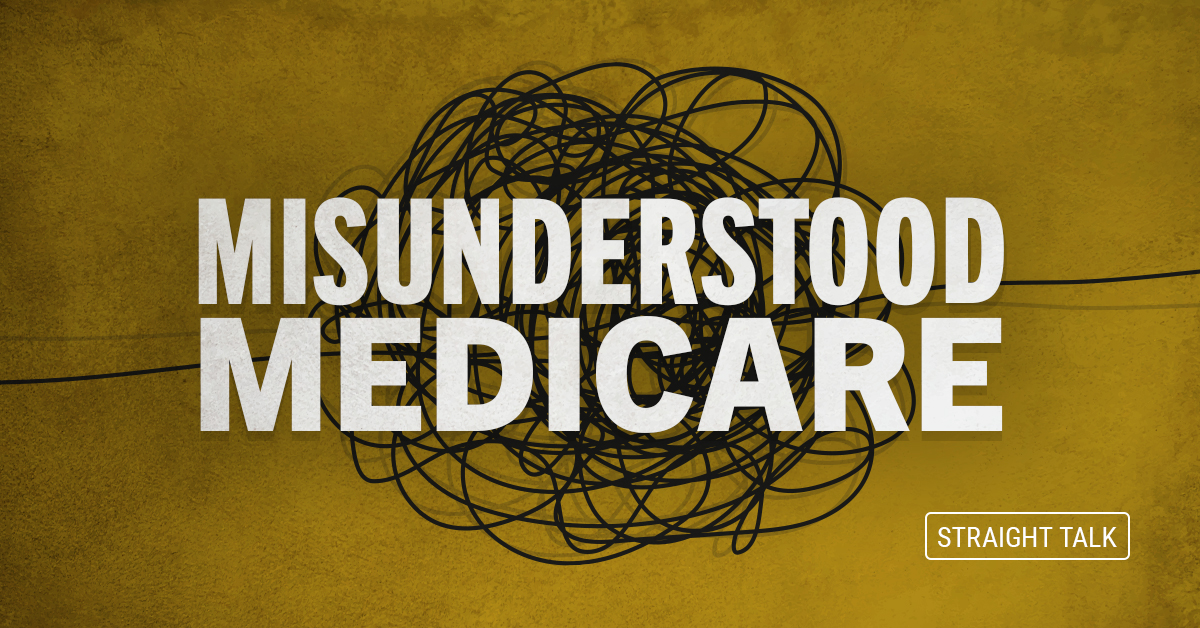Today, more than 50 years after it was signed into law, what we call “Medicare” may be the most misunderstood program the government has. Since the Annual Enrollment Period for Medicare plan members begins Oct. 15, and because Congress is looking really hard at changing Medicare right now, I thought this was a great time to review a few things about the program.
How It Started
In the interest of protecting the health of older adults once their working years wound down, Congress created the Medicare program in the mid-1960s with three specific goals:
- Create a trust fund that would endure throughout the ages for their healthcare
- Use this trust fund to cover hospital costs, and then later, physician and outpatient costs, as well as prescription drug costs
- Encourage equal treatment of all older adults, regardless of race, when they sought healthcare
How It’s Going
Today, Medicare is actually offered via THREE separate insurance plans. How does THAT work? Let’s do our ABCs – the ABCs of Medicare, that is:
The first is Medicare Part A.
If you have worked at any point since 1965, odds are you and your employer have been contributing 1.45% of every paycheck into the Medicare Part A Trust Fund. If you contribute for at least 40 quarters of work during your lifetime, you are eligible for Medicare Part A. You don’t pay any premium for this coverage; it is paid for through the tax dollars you and other employees put in over the years. If you don’t work or contribute for those 40 quarters during your lifetime, you’ll need to pay monthly premiums of $471 or more for Medicare Part A, depending on your income. Your quarters are listed on your Social Security statement, so check there to see where you land. And they don’t have to be consecutive; just add up to 40.
Medicare Part A
Medicare Part A helps pays for things like hospital stays, skilled nursing, hospice and home health services. It does not, however, cover unlimited medical costs with no contributions from you. The current deductible, for example, is $1,484 per year. Long hospital stays can generate very large out-of-pocket bills as well.
For example, if you are in the hospital for:
0 through 60 days in a calendar year: It costs $0/day extra coinsurance
Day 61 through 90: It costs $371/day extra coinsurance
Day 91 and beyond: You must pay $742/day and use up your “lifetime reserve days,” of which you get 60
Run out of ‘lifetime reserve days? You pay 100% of all remaining hospital costs!
To clarify how this works, if I were in the hospital for 120 days, I’d pay $0 for days 1 – 60, $10,759 dollars for days 61-90 ($371 x 29 days) and then $21,518 for days 91-120 ($742 x 29 days), for a total of $32,097.
It’s easy to see that even with Medicare, a person could end up owing a ton of money if she got really sick. And this isn’t the ONLY gap Medicare members face. Stay tuned, I’ll explain those and then cover some solutions.
Medicare Part B
Medicare Part B covers medical services considered necessary to treat a disease or illness. This typically includes coverage for things like lab tests, surgeries and doctor visits. It also covers certain preventive services. Although Medicare Part B is pretty good insurance, it still has a premium (at least $148.50 per month for most members this year), a deductible ($203 this year) and requires 20% coinsurance WITH NO LIMIT beyond the deductible. That means no out-of-pocket maximum. Imagine you have a serious illness, one that requires expensive outpatient treatments like dialysis or chemotherapy. Imagine being on the hook for 20% of those costs, with no maximum out-of-pocket cap annually. It could happen with STANDARD Medicare Part B.
Happily, there are solutions to these problems. The first one we’ll discuss are Medicare Advantage plans, or Medicare Part C.
Medicare Part C/Medicare Advantage
Medicare Advantage (MA) plans, offered through private insurers like Blue Cross, provide comprehensive, wrap-around coverage. That lowers what you might have to pay out of pocket for treatments that fall in the holes in Medicare Part A and B. Many MA plans don’t have a monthly premium. In exchange, the MA member typically agrees to use a plan’s specific network of doctors and hospitals when seeking treatment.
By law, MA plans are required to have maximum out-of-pocket limits to protect members financially. Some MA plans include prescription drug coverage (that’s Medicare Part D), making it a true turnkey solution for a person turning 65. Carriers are even profit-limited by the federal government when they sell MA plans, and the government tightly monitors their financials and performance. This is to ensure that “private Medicare” gives members all the same protections as standard, government-issued Medicare. Most MA plans actually offer more protection.
You can sometimes get an MA plan through your employer. They are rare but growing. If you are over 65 and still working, talk to your Human Resources department about what you need to do.
Don’t let the alphabet soup scare you – check out our “Medicare Made Easy” video (5:20), in which I walk you through the different letters and what each covers.
Today’s Medicare: More Choices, Greater Flexibility
Almost half of Medicare-eligible adults are enrolled in an MA Plan. These plans have become VERY popular because of their solid financial protection for members when they seek healthcare.
Medicare Supplement
Another option for members is to stay on traditional Medicare Part A/B and buy a supplemental insurance policy to fill in all the gaps separately. This coverage, called Medicare Supplement or “Medi-Gap,” has been around for many years and is also quite popular among Medicare members.
Why? Imagine a policy that just covers all the expenses we listed above — the 20% coinsurance on Part B, the $371 per day or $742 per day a member pays for longer hospitals stays — Medi-Gap plans would lower those costs to $0. Because Medi-Gap insurers don’t take over for Medicare, but merely plug the holes, the plans require premium payments that increase with age. Over 20% of all Medicare members (around 13 million people) have a private Medi-Gap coverage plan.
Lower-income Medicare members may be eligible to receive assistance with their premiums AND cost sharing through their state’s Medicaid programs. These folks are often called “dual-eligibles” because they are members of both Medicare AND Medicaid. At any given time, another 20% of Medicare folks are “dual eligible” and their premiums and any coinsurance or cost sharing is paid through a state/federal partnership.
Add it up, and you can see that standard, government-issued Medicare members are few and far between. About 65 million1 people are in Medicare today. Of those, about 27 million are in MA plans; 18 million have supplemental plans to fill in the gaps; and 8 million are on employer plans, where their employers are taking the Medicare money and doing everything for them. There aren’t too many people are on “regular” Medicare – about 12 million or so.
Straight Talk is, the current Medicare marketplace is both flexible and comprehensive for members. Whether they prefer a straight, government solution or a private one, choices abound. Medicare is an excellent, basic federal health insurance program, now celebrating its 56th year of existence, and we should not take it for granted.
A note to Medicare members:
If you qualify for Medicare, you’ll soon be able to review your 2022 plan options. Insurers selling Medicare plans can start sharing information about them Oct. 1, and the Annual Enrollment Period goes from Oct. 15 – Dec. 7. Coverage on the plan you select during this time starts Jan. 1, 2022. I’d strongly encourage you to talk to your friends and family on Medicare plans to explore your choices. Check to make sure the doctors you want to see, the drugs you take regularly and any plan extras like fitness services you want to have are on your plan before signing up. If you need free help from a professional, you’re welcome to speak to one of our agents trained in Medicare. Call 1-800-568-1417 (TTY 711) or visit bcbslaplan.com/medicare. There is no obligation to buy because you talked to an agent.
1 https://www.cms.gov/research-statistics-data-systems/cms-fast-facts/cms-fast-facts-mobile-site





Leave a Reply